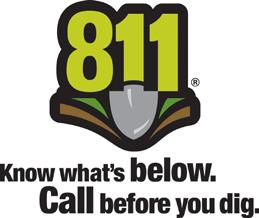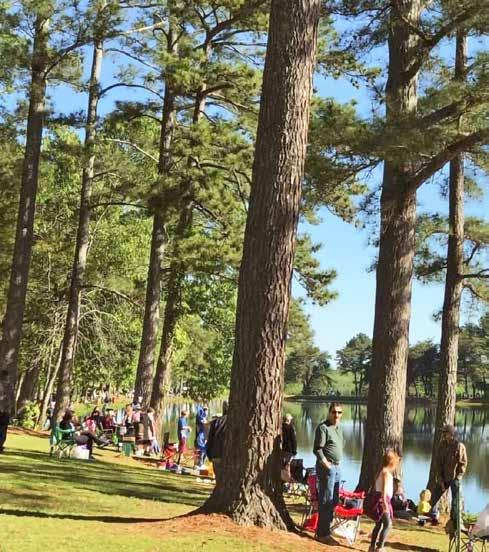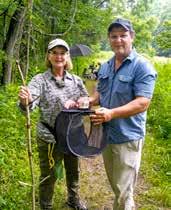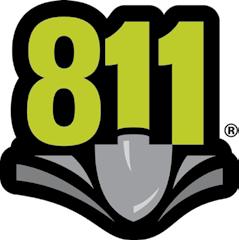

Discover outdoor fun close to home




Discover outdoor fun close to home

By Shirley Bloomfield, CEO NTCA–The Rural Broadband Association
NTCA members create broadband networks so fast and reliable that it’s easy to take for granted the effort and expertise needed to bring these services to homes and businesses. These professionals do amazing work, particularly when considering the intricate, multistep journey to build, expand and maintain a network.
It begins with detailed research and careful planning. The broadband provider must learn exactly how many homes and businesses might want service, as well as the challenges posed by the landscape. Then, a thorough review of the numbers determines if the project makes financial sense. It’s a puzzle where the pieces are population density, infrastructure costs and potential demand for the service.
Then there’s the engineering—design, build and inspect. Detailed maps identify routes for cables, permitting, environmental regulations and access to land. Some of these projects can take two to four years from the first engineering drawing to the first connection.
The work doesn’t stop when the network goes live. These networks require maintenance, technology upgrades and customer support.
These networks are lifelines connecting rural communities to telehealth, education, remote work and cutting-edge technologies. With the help of service providers like yours, we’re building broadband to last and ensuring no community gets left behind in our increasingly digital world.
To learn more, check out the Foundation for Rural Service and JSI’s latest report, “Delivering Broadband From Beginning to ‘End,’” at frs.org/deliveringbroadband-beginning-end.

When you need information fast, a quick check of Google is often the first stop. In fact, some people find it easier to search online for everything, including the addresses for a specific website like a bank, trusted repair service or health care provider.
Unfortunately, scammers know this, too, so they sometimes create bogus sites with addresses confusingly close to the real thing.
Google is aware of this trend, and it touts advanced systems that keep users’ search results 99% spam-free. The company also offers a few tips for closing the final security weaknesses.
• Pay close attention to the URL—the specific web address—before clicking any unfamiliar link. Typically, in an email, hovering the cursor over the address will show the complete link. Don’t click the link if it looks suspicious.
• The three dots next to the search results in Google can be used to find more details about the webpage, store or business you’re considering. You can find clues indicating if the site is legitimate before clicking the link.
• When you’re looking for official resources, watch out for unusual address formatting. For example, there’s typically only one correct customer service number for a larger company. But not all businesses have customer service numbers, and searching for them requires you to be mindful. Watch for strange formatting in the website address, including unexpected symbols or emojis.

Story by BRANDI DIXON
Hannah Dasher is a blast of classic country and rock ’n’ roll paired with social media influencer. Stepping into the home she calls “Honky-Tonk Graceland” and features on her social media is, as Hannah says, like going back in time to “your meemaw’s house.”
“Avocado green canisters, gold salt and pepper shakers, brass pots. I love my retro kitchen, and I love that the fans feel right at home,” she says, adding that she enjoys entertaining.
Music and songwriting are Hannah’s first loves. “I was rehearsing my acceptance speech for best new female vocalist of the year in my mirror at age 10,” she says. “I grew up listening to ’90s country radio, and knew I wanted to be an entertainer.”
Hannah pursued music professionally, taking her big hair and a heaping helping of Southern charm to Nashville, Tennessee. She started out writing songs for other artists, getting some big accolades thanks to collaborations with Brad
Paisley, Lainey Wilson and Ian Munsick, to name a few. She continued performing whenever she had the chance.
In 2020 during the pandemic, Hannah found herself stuck. “All the stages shut down, and I needed a stage,” she says. “Talking with some friends I learned a lot of girls my age couldn’t cook, so I stumbled into the world of social media, and it was the perfect storm.”
Hannah took to TikTok to share her
family’s beloved recipes and a few of her own, all while sprinkling in a bit of her signature rockin’ country flavor. The recipe produced the now-viral Stand By Your Pan social media accounts. More than 1.5 million followers join Hannah daily in her retro kitchen.
“I love that this brought country and noncountry music fans together,” she says. “It’s hard to pigeonhole into just one world, and I’m glad that I can be this representative of the past and the future via a semicelebrity chef.”
When Hannah Dasher isn’t cranking out content, she’s picking up a guitar and writing music.
“God always sends it from the left side of the sky and out of my mouth,” she says of her process. “Sometimes it’s melody and lyrics simultaneously, but you just never know, and you always have to be looking for it.”
Hannah is on the road this year with her band on The Wanted Tour, featuring stops across the United States, the United Kingdom and Sweden. She encourages fans to spread the word and come see her and her “boys.”
Ardmore Telephone Company takes great pride in delivering reliable, high-speed internet to our customers. Whether you’re working from home, attending virtual classes, running a business or simply streaming your favorite shows, you rely on our network to keep you connected. But many people don’t realize how fragile that connection can become when someone starts digging without taking the proper precautions.

KAREN JACKSON-FURMAN Chief Executive Officer
Across our service area, thousands of miles of cable run underground, connecting homes, businesses and essential services to our world-class network. This infrastructure is carefully installed and maintained to withstand the elements, but there’s one threat that can’t be completely avoided—accidental damage caused by digging.
Each year, ATC responds to multiple incidents where fiber lines are cut by individuals, contractors or utility crews who dig without first calling 811. It might be someone installing a new fence, planting trees or even working on a driveway or patio. Whatever the project, failing to locate buried utilities before digging puts our fiber—and your neighbors’ connections—at serious risk.
When a line is cut, the effects are immediate. Homes lose internet, businesses lose access to payment systems and communication tools, students can’t complete online assignments, and patients miss telehealth appointments. In some cases, even emergency responders lose connectivity to critical systems. What starts as a simple backyard project can suddenly disrupt life for dozens—or even hundreds—of families.
Restoring service after a cut is a complex, time-sensitive process. Our crews must find the damage, carefully expose the cut line and make delicate repairs to restore the connection. Depending on the severity and location, these repairs can take hours or even days to complete.
But the costs go far beyond time and materials. There’s a financial cost for the repair itself, which may ultimately be passed on to the party responsible for the cut. There’s also the community cost—lost productivity for remote workers, disruption for businesses and frustration for families trying to go about their daily lives. And perhaps most importantly, there’s the potential safety cost if emergency services or telehealth providers are unable to communicate.
The good news is that these cuts are completely preventable. By simply calling 811 before starting any digging project, you ensure that all underground utilities, including our lines, are properly marked. This free service takes just a few minutes to schedule but can save hours of frustration and thousands of dollars in damage.
At ATC, we work hard to provide reliable service, but we can’t do it alone. Protecting our network is a shared responsibility. Whether you’re a homeowner working on a weekend project or a contractor breaking ground on a major development, calling 811 is the law, and it’s the right thing to do.
For more information about safe digging practices and the importance of calling 811, visit www.call811.com. Thank you for helping us protect our network and thank you for being a valued part of the ATC family.

3
The Ardmore Connection is a bimonthly magazine published by Ardmore Telephone Company, © 2025. It is distributed without charge to all customers of the company.

is a hometown service provider delivering advanced telecommunications technology to the people of Giles and Lincoln counties in Tennessee and Limestone and Madison counties in Alabama. The company is managed by Telecom Management Services and owned by Synergy Technology Partners.
Ardmore Telephone is an equalopportunity employer and provider.
Ardmore Telephone Company P.O. Box 549 Ardmore, TN 38449 Telephone: 256-423-2131 or 800-830-9946 www.ardmore.net
Ardmore Office: 30190 Ardmore Ave. Ardmore, AL 35739 Monday - Friday 8 a.m. - 4:30 p.m.

Find us on Facebook and Instagram!

On the Cover:

Sharon Johnston Park hosts events all year to raise money to restore the Pioneer Village that was relocated there in 2018. See story Page 8.

During the 2025 NTCA Excellence Awards in February, NTCA–The Rural Broadband Association presented the James L. Bass Manager Life Achievement Award to former Ardmore Telephone Company CEO Trevor Bonnstetter.
The NTCA Excellence Awards recognize broadband providers who exceed expectations to support their customers and community members and to advance communications services in rural America. Congratulations
























In honor of Memorial Day, our offices will be closed on Monday, May 26.


Story by JOHN CLAYTON
Ric Sisler admits he misses the annual spring-to-fall marathon of a baseball season. “When it’s in your blood, it doesn’t matter what you’re doing. You’re always going to be pulled toward that industry, and I’m
WHAT’S IN A NAME?
certainly no exception,” he says. “Going to the ballpark, the camaraderie and being around the yard was just a thrill for me.
“I certainly don’t miss tarp pulls and some of those types of things,”
Marketers and merchandisers will say quite a lot. Creative—some may say outlandish—nicknames, mascots and logos are part of the landscape of minor league baseball. Here are a few of our favorites:
Florida: The Fort Myers Mighty Mussels—The nickname is more about seafood than sinew.
Alabama: Rocket City Trash Pandas—It pairs Huntsville’s role in the space industry with a cute raccoon reference.
Georgia: Augusta GreenJackets—The GreenJackets mascot is
Road trip to baseball’s most entertaining destinations
he says with a laugh, referring to the back-breaking work of getting protective tarps on and off the diamond during rainy weather.
The national pastime is most certainly in Ric’s blood. He played for three
akin to a yellow jacket, but the reference is to Augusta’s long history with The Masters golf tournament, which awards the winner a green jacket.
North Carolina: Kannapolis Cannon Ballers—The alliteration is nice for the team once known as the Intimidators after the late NASCAR star and Kannapolis native Dale Earnhardt Sr., who was then part-owner of the team. The Cannon Ballers mascot, Boomer, has an uncanny resemblance to Earnhardt.
Kentucky: Bowling Green Hot Rods—The nickname gives the team a link to the nearby National Corvette Museum.

seasons in the New York Yankees minor league system before running several minor league organizations as a front office executive and as vice president/ general manager of the independent South Coast League based in Georgia. His father, Dick Sisler, was a Major League Baseball manager and All-Star player, and his grandfather, George Sisler, is enshrined in the National Baseball Hall of Fame.
Ric, who is still involved in athletics as director of corporate sponsorships at Western Carolina University, says many fans of the game come back season after season.
“Minor league baseball has been part of the fabric of our society in a lot of smaller towns,” he says. “It was kind of a binding agent for folks to come watch baseball with their friends and neighbors and just have a wholesome time.”
While the minor leagues are about family fun and community pride to many fans, the game is a balance of business and player development for the teams and their MLB affiliates. The minors have long relied on fan-friendly, creative promotions and player interactions to sell tickets, and all of that comes with an affordable price tag.
“I think people have always gone to minor league games because it’s
affordable,” Ric says. “You had great entertainment and could see some potential big-league players there at

an affordable price. You’re very close to the field and close to the players. It was a different setting from the Major League parks. I don’t want to see that change.”
Planning a trip this summer––or maybe even a baseball pilgrimage? There’s a game, sports history and tradition, as well as a bunch of fun waiting for you.
Some of the oldest ballparks in the country are in the Southeast, and three of them are on the National Register of Historic Places.
That list includes Birmingham, Alabama’s Rickwood Field, which is the nation’s oldest professional baseball park still with its original structure. Opened in 1910, two years before Boston’s Fenway Park, Rickwood was home to the Negro Leagues’ Birmingham Black Barons.
The double-A Birmingham Barons play an annual ceremonial game at Rickwood, and Major League Baseball hosted a game between the St. Louis Cardinals and San Francisco Giants at the venerable ballpark last season, a 6-5 Cardinals victory.
Jackie Robinson Ballpark in Daytona Beach, Florida, was the first ballpark to allow the Brooklyn Dodgers’ African American prospect whose name now graces the stadium to play with white players in the segregated South in 1946. The park dates to 1914 and was originally named Daytona City Island Ballpark.
Spartanburg, South Carolina’s Duncan Park was constructed in 1926 and was home to minor league baseball almost continually until 1994. It was also home to the Spartanburg Sluggers, a Negro League minors team from 1928-52. An estimated 21,000 spectators reportedly crowded in and around the ballpark to attend Game 5 of the 1938 American Legion World Series between Spartanburg and Los Angeles.
The 3,000-seat stadium is currently Spartanburg High School’s home field. The city of Spartanburg is building a new stadium for the Hub City Spartanburgers of the South Atlantic League. The city is the new home of the former Down East Wood Ducks of Kinston, North Carolina.
Story by DREW WOOLLEY
Sharon Johnston Park has been a favorite spot for Corrine Brandon and her family for years. Living in nearby Meridianville, she felt the park was worth the drive.
“I have always loved that park. My kids have gone over there, and now my grandkids go over there,” Corrine says. “We camp over there even though we live in Meridianville. We take our camper and go there just to get away. It has just been the best little place.”
Three years ago, after Corrine retired from her career as a nurse and started working in telecommunications, Regina George with the Madison County government approached her about joining the Friends of Sharon Johnston Park board. Corrine jumped at the opportunity.
The first task the nonprofit group set its sights on was restoring the Pioneer Village, a living museum of what life was like for early settlers of Madison County. The buildings were moved to the park from the Paint Rock area in 2018, and now the goal is to repair them as a destination for local families and history buffs.
“We just want to do all we can do to get this Pioneer Village ready for the children from the local elementary schools to come and see how rural life was in the 19th century here in Madison County,” Corrine says.
About half of the buildings in the Pioneer Village are authentic structures from the period, while the rest are replicas. That means much of the work Corrine and the Friends of Sharon Johnston Park need to put into them requires specialized skills.
“It is hard to find a carpenter to work on those old buildings,” she says. “And, of course, we are having to put electricity in them so we can put in lights and make sure everything is safe for whenever we have an event at the park.”
For Corrine, that work is worth it to have a historical attraction right down the road that she believes will draw visitors from neighboring states as well. Her granddaughter, Kate, who is in eighth grade, already loves visiting the Pioneer Village in its

current form, and Corrine hopes it will be even more exciting when her younger grandkids get to appreciate it.
“I’ve got three grandchildren, and I know how they are when I say, ‘No more tablet,’” she says. “There’s a benefit in having them see how different life was years ago and how hard those people worked, maybe even how hard our great-grandparents worked, to get them to the place the family is today. I think that’s the legacy that we want them to look at.”
To support that effort, Friends of Sharon Johnston Park puts on several events throughout the year to help raise money for the restoration effort, including an upcoming car show and fishing rodeo in May. The Pioneer Village is open to visitors during those events, but there are also many other draws for families looking to spend time outdoors.



Sharon Johnston Park hosts fun family events throughout the year. Be sure to check the Facebook page for updates and announcements for your next family outing.

The park’s disc golf course, added several years ago, has already become one of the premier courses in the state. Designed by a professional disc golfer, the course will be one of those hosting the Amateur Disc Golf World Championships when the event comes to Huntsville in 2027.
Families are also welcome to get a permit to fish in the pond or pitch a tent at one of the park’s designated campgrounds. For Corrine, it all adds up to one of the best-kept secrets in the county, but she is eager to spread the word.
“It has so many things that you don’t know until you go see it,” she says. “So many times I meet people who just Googled nearby activities or would have never known we have this. They also tell me they loved it and will definitely be back.”
Bring your own restored vehicle or come enjoy the dozens of classics on display. Grab a bite to eat at one of the food trucks, and find the perfect last-minute Mother’s Day gift from one of the many craft vendors. Kids have the chance to sit on antique tractors, and everyone can enter the prize giveaways.
Local kids have the chance to cast a line in the freshly stocked lake to compete for the biggest catch. The fishing rodeo is a decadeslong Sharon Johnston Park tradition, and everyone wins a prize.
The park’s biggest annual event decks everything out in fall decorations and puts local students’ skills to the test in a pumpkin-painting contest. Come vote for your favorite, take part in the sweets walk or just enjoy face painting, food trucks, snow cones, vendors and a variety of kids’ activities. The Pioneer Village is also open for anyone to explore at their own pace.

Story by SARA DIAMOND PATTERSON
Catching lightning bugs in a Mason jar with holes punched in the lid is a summer ritual for kids across the country. Watching their light show together is often a time for families to slow down, which is what Lynn Frierson Faust’s family began doing in the Great Smoky Mountains during the 1960s.
They marveled for years at the unique light display, as the flying beetles blinked on and off at the same time for several hours after dark. When Lynn heard the August 1991 edition of Science News magazine featured an article on fireflies that blink in unison, she figured she would finally find out why and how they made their magic.
“I remember thinking, ‘Oh cool, a lightning bug feature. It’ll talk about our light show.’ Only it didn’t mention one thing,” she says. In fact,
the authors said the Western Hemisphere had no species of fireflies that blinked synchronously.
Lynn let them know they were mistaken and invited them to come to the Smokies to see the show for themselves. The scientists did and agreed Lynn was right, lighting the way for her life’s work.
‘JUST SO DARN FUN’
As “The Lightning Bug Lady,” Lynn is internationally known for her research on the ecology and habits of the more than 125 species of U.S. fireflies, helping
HOW: Fireflies produce their magical flashes through bioluminescence, a chemical reaction.
WHY: Each of the more than 125 species of fireflies in the United States—2,000 worldwide—has a unique signature flash pattern the males use to attract females of their specific type.
WHERE: Everywhere. Many Western species do not flash or fly, but they’re out there.
WHEN: Warm summer nights.

Pesticides and habitat reduction have taken a toll on firefly populations. Maintaining a “wild” area of your yard with a little water, native vegetation and undisturbed soil will make your home more firefly friendly. But the easiest way to help is simply by turning out the lights during their active period. Visit xerces.org or firefly.org for more tips.


A BBC crew takes a break from filming in 2019. Naturalist Lynn Frierson Faust examines equipment she and Mark Zloba, ecological manager at the Edge of Appalachia, use to gather fireflies at the preserve outside of Cincinnati.
to raise awareness of their unique life cycles and importance within ecosystems.
She scrambles to 14 states each year to catch them emerging during their eight-week active season, usually early June to late July. For 18 years, she has been the worldwide go-to on the subject, serving as on-site scientific consultant for BBC Earth, Discovery, National Geographic and other international film crews. Lynn’s 2017 book, “Fireflies, Glow-worms, and Lightning Bugs,” was the first-ever comprehensive firefly field guide and shared the results of her nearly three decades of research on behalf of museums, universities, state and national parks and nature centers.
“I’m not a scientist per se, but I’ve done the research, a whole lot of research,” she says. “I’m just a regular person obsessed with these and fortunate to have the time and a little knowledge to build on.”
Throughout history, fireflies have symbolized hope and mystery, serving as transient reminders that life is fleeting. In some cultures, people see them as their lost ancestors, a sacred connection between the earthly and spiritual worlds.
When she began, Lynn didn’t have much research to start with. “There were just a bunch of dusty old scientific papers, but that’s about it,” she says. “There’s just not been that much research done on them since they aren’t harmful or helpful to people or crops.”
They are, however, a great indicator species for the health of ecosystems. “When they disappear, we have to know why and where to look.” And
No matter where you are, you don’t have to go far to find the magic. You can look for lightning bugs anywhere from your backyard to wildlife management areas or wooded parks, avoiding light pollution and areas that spray for mosquitos.
The Southeast offers the most variety of firefly species. “Generally speaking—and this holds true for almost all living things—as you go south closer toward the equator, you get a greater diversity of species but maybe fewer numbers,” firefly expert Lynn Frierson Faust says. “Whereas when you go north in latitude, you get greater numbers but fewer species.”
The Photinus carolinus species in the Great Smoky Mountains National Park of Tennessee and North Carolina are known for their synchronous flashes. You can see them put on a similar show at South Carolina’s Congaree National Park. Thousands of these fireflies emit between five to eight flashes of light all at once followed by eight to 10 seconds of darkness.
Their light shows have become so popular, each year more than 20,000 people enter a lottery drawing at each park for viewing spots during the two-week active period, usually in early June depending on temperatures and soil moisture.
Lynn says they will always serve as a nostalgic reminder of days gone by.
“Lightning bugs are fantastic ambassadors leading people back into nature and to a better understanding of the connectedness of it all,” she says. “Plus, they’re just so darn fun.”
Officially known as Lampyridae, worldwide fireflies are called blinkies, glowflies, moon bugs, peeneywallies, blinkin’ bees, hoturu, fire beetles and candle flies. Here at home, “lightning bug” is more common in the South and Midwest, while “firefly” is typically heard in the West and large cities in the East. Some researchers attribute the differences to weather. While lightning is most active in the South and Midwest, the West sees the most wildfires.
Story by DREW WOOLLEY
It’s hard to get more family than at Cassie’s Cafe. Owner Lorrie Eakes grew up helping her mother in local eateries, so once she was old enough it was a foregone conclusion that she would open a restaurant of her own.
“We’re just used to serving the community. Everybody says we’ve got cooking oil in our veins,” she says. “Every time we’ve thought about getting out of restaurants, it just draws us right back.”
The local chain takes its name from Lorrie’s daughter, who previously ran another restaurant of the same name. When the original Cassie’s closed, Lorrie thought her family might be done with the restaurant business. But their customers were so insistent they reopen in a new location that she couldn’t resist bringing it back in 2009.

“We had sold everything,” she says. “But I woke up one morning and all the people in the community, the farmers and everybody, called me and told me we’ve got to have some place to eat.”
Today, Cassie’s has locations in Ardmore, Hazel Green, Toney and Huntsville. Each cafe features the same popular meat-and-three menu, opens for breakfast and offers steak and seafood for dinner. But as hiring new staff increasingly becomes a challenge, Lorrie is considering opening another location focused on carryout orders for customers who don’t want to come and sit down for every meal.
Serving her customers is her favorite part of the job. “Some of our customers we see three times a day. They’re very

supportive,” Lorrie says. “When COVID shut everything down, we had to change our model and start doing delivery and a lot of carryout. But people really started paying attention and shopping local momand-pop places. That’s what we live for. Our customers just become an extended part of our families.”
During the early days of the pandemic, the Ardmore cafe relied heavily on its service from Ardmore Telephone Company to take to-go orders and promote the restaurant on social media. Without it, Cassie’s might have struggled to survive such a challenging period, and the community could have lost an important local gathering place for good.
“Having local restaurants like ours grows better community ties,” Lorrie says. “I think people in the community just appreciate knowing that you are local. If there’s a problem, they know your family and they know they can come to you.”


Ahigh-speed internet connection opens all kinds of digital opportunities, from taking classes remotely and running a business online to working from home or queuing up your favorite show at the end of a long day. Ardmore Telephone Company works hard each day to make sure that service is reliable and affordable for our customers. But no amount of planning can prevent outages that happen when lines are accidentally cut.
Every year ATC responds to multiple incidents where individuals, contractors or other utility crews have cut a line because they did not call to have them marked before digging. Digging without first checking for underground utility lines not only runs the risk of interrupting service, it can also result in serious injury. Many utility lines are buried just a few inches below the surface. So, even if you’re only planning a small gardening project, it’s important to call before you dig.
If you plan to dig on your property, protect yourself and your community by following these simple steps:
Call—Dial 811 two to three days before digging starts to notify your local onecall center of your plans. You can also make a request online at www.al811.com. The center will then notify any affected
utilities in your area to come out and mark their lines.
Wait—Do not start digging until the relevant utilities have had time to respond to your request. On average, it takes the center two to three days to provide you a list of utilities that were notified.
Mark—Confirm that all utilities have responded to your request by checking the list provided by the one-call center. Make sure each one has marked any underground lines on your property.
Avoid—Follow the marks provided by each utility. Avoid digging on any marked

ground. If the marks are hidden or disrupted during your work, call 811 to have them re-marked.
Dig—Be aware when you dig. If it isn’t possible to avoid digging near the marked areas, consider moving your project to another part of your property.
A call only takes a few minutes but can help you avoid injury, interrupted service and unhappy neighbors. So, the next time you’re planning a weekend yard project, call 811 or visit www.al811.com first.

If you’re having any problems with your internet, please call us so we can work through service issues together. We are committed to making your connection an outstanding experience.


Many say munching on piping-hot, crispy fried chicken is a joy like no other. Whether it’s juicy white meat from the breast or the wings or the deep, engaging flavors of the dark meat found in thighs and legs, when it comes to fried chicken, most everyone has a preference. But there are a few things that good pieces of fried chicken have in common—the skin must stay on, and it must be crispy.
That’s not too much to ask, but it’s something that many cooks cannot achieve. There’s a knack to it that may take a few extra steps, but the endgame is well worth it.
Serve the chicken alongside a big spoonful of potato salad and finish with a bowl of banana pudding and you have a meal fit for a beautiful summer evening.

Food Editor Anne P.
Braly
is a native of Chattanooga, Tennessee.
Photography by Mark Gilliland
1 (4-pound) chicken, cut into pieces
1 cup whole milk buttermilk
2 cups all-purpose flour for coating
1 teaspoon paprika
1 teaspoon garlic powder
Salt and pepper to taste
2 quarts vegetable oil for frying
Dry chicken with paper towels. Put the flour in a large plastic bag. Let the amount of chicken you are cooking dictate the amount of flour you use. Season the flour with paprika, garlic powder, salt and pepper to taste. Paprika helps to brown the chicken.
Dip chicken pieces in buttermilk then, a few at a time, put them in the bag with the flour, seal the bag and shake to coat well.
Place the coated chicken on a cookie sheet or tray, and cover with a clean dish
towel or waxed paper. Let sit until the flour reaches a paste-like consistency. This step is important to ensure that the skin will be crispy and adhere to the chicken.
Fill a large skillet (cast iron is best) about 1/3 to 1/2 full of vegetable oil. Heat until very hot.
Put in as many chicken pieces as the skillet can hold. Brown the chicken in hot oil on both sides.
When browned, reduce heat and cover the skillet. Let cook for 30 minutes (the chicken will be cooked through but not crispy). Remove cover, raise heat again and continue to fry until crispy. Drain the fried chicken on paper towels. Depending on how much chicken you have, you may have to fry it in a few batches. Keep the finished chicken in a slightly warm oven while preparing the rest.

4 pounds russet potatoes
1-2 tablespoons olive oil
3 tablespoons apple cider vinegar
1 cup mayonnaise
3/4 cup sour cream or full-fat Greek yogurt
1/2 cup cheddar cheese
1 teaspoon kosher salt
1 teaspoon freshly ground black pepper
12 ounces bacon, cooked, cooled and chopped
6 green onions, whites and green parts, chopped
Preheat the oven to 400 F. Place cleaned potatoes on a baking sheet and pierce four to five times with a fork. Lightly coat with olive oil, sprinkle with kosher salt and cook for 50-60 minutes or until easily pierced with a cake tester or skewer. Remove from the oven and let cool for 5 minutes. When cool enough to
8 ounces softened cream cheese
1 (14-ounce) can sweetened condensed milk
2 (3.4-ounce) boxes instant vanilla pudding
2 3/4 cups cold milk

handle, peel the potatoes and cut into 1-inch chunks, discarding the potato skins. The potato flesh may crumble and get shaggy, and that’s OK—transfer it all to a large mixing bowl. While still warm, sprinkle the potatoes with the apple cider vinegar. Set aside for 15-30 minutes or until the potatoes are cooled.
Meanwhile, cook the bacon in a large skillet or in the oven, drain and let cool. Crumble into bite-size pieces.
In a small bowl, mix the mayonnaise and sour cream. Season with the kosher salt and pepper.
When the potatoes are cool, pour the mayonnaise mix over them with the crumbled bacon, green onion and cheddar cheese. Gently fold the ingredients together. Season with more salt and pepper to taste. Refrigerate for 3 hours up to overnight before serving. Store in the refrigerator for up to four days.
8 ounces whipped topping divided 1 (1-pound) package Nutter Butter or other peanut butter sandwich cookies
5-7 ripe bananas, sliced
In a large mixing bowl, beat the softened cream cheese until smooth. Add the condensed milk and mix until there are no lumps.
In a second bowl, mix the pudding mix and milk together until smooth. Pour the pudding into the cream cheese mixture and mix until completely combined. Fold in half of the whipped topping.
Line the bottom of a trifle dish with a layer of Nutter Butter cookies. Add a layer of banana slices on top of the cookies. Spread a layer of the pudding mixture evenly over the bananas. Repeat 1-3 times, depending on the size of your dish. Spread the remaining whipped topping on top of the pudding. Cover and chill for at least 4 hours but overnight is best.
Crush a few Nutter Butters on top of the whipped topping immediately before serving.


